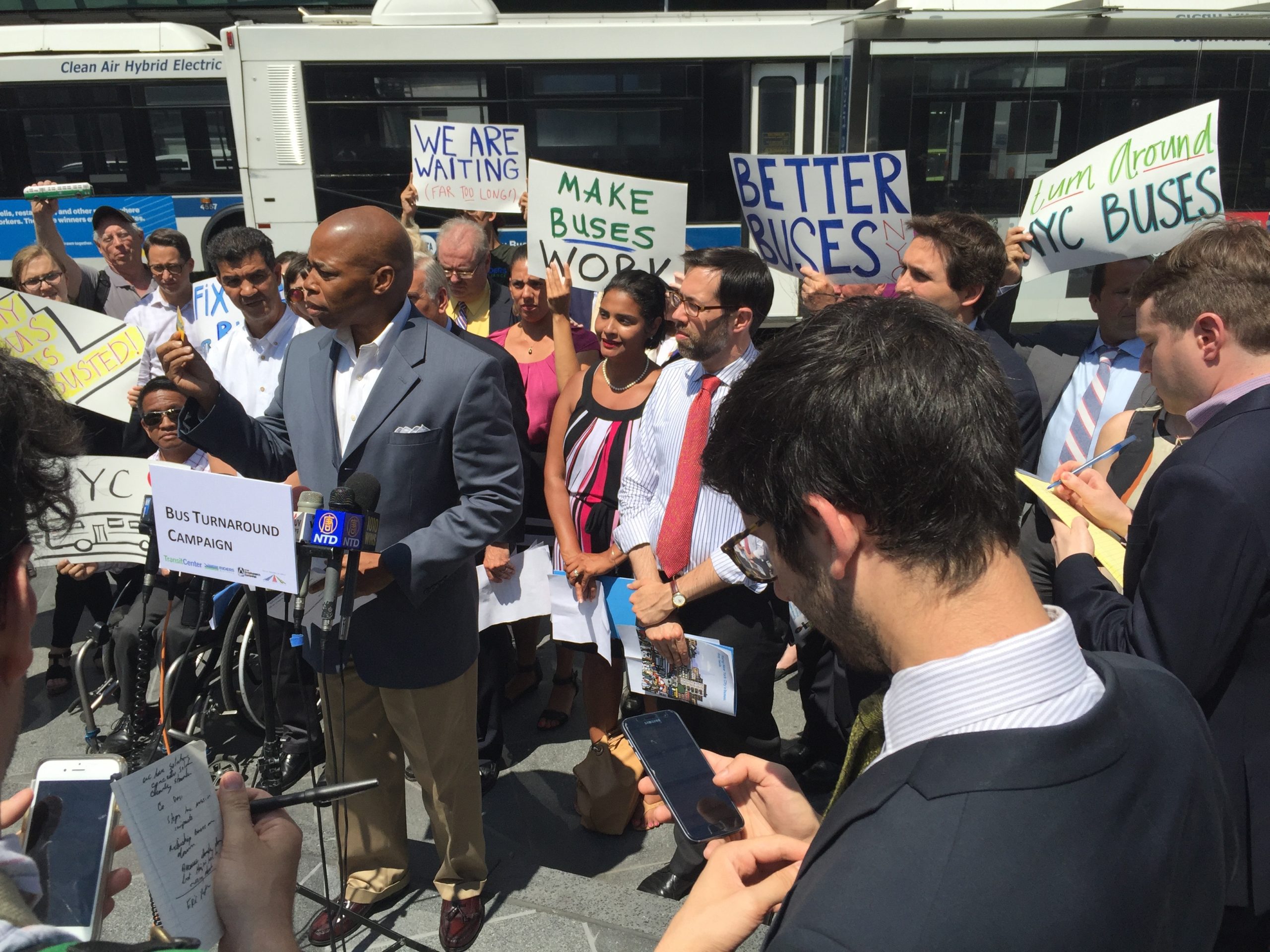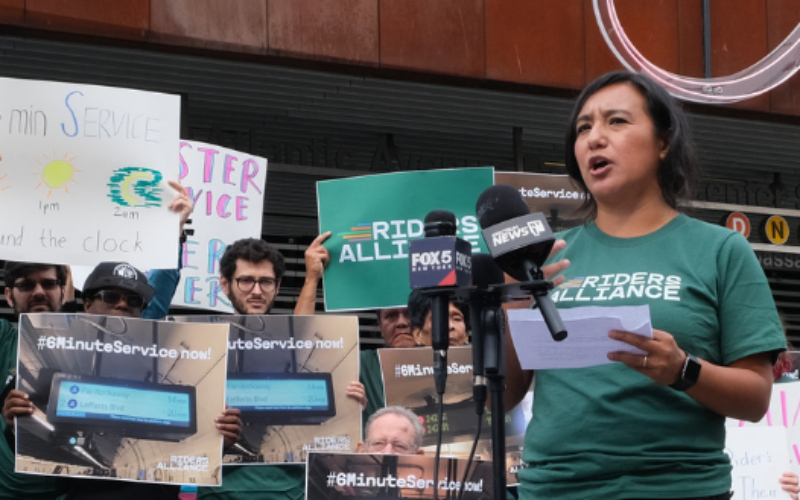
Eric Adams speaks at the launch of the Bus Turnaround Campaign in 2016.
With this week’s election, millions of New York City transit riders now look to mayor-elect Eric Adams to turn around slow and unreliable bus service.
Adams campaigned as a mayor who’ll work for blue-collar New Yorkers, and the bus is New York’s blue-collar mode of transportation. The average income of bus commuters is below that of both car commuters and subway commuters. Black and brown New Yorkers, immigrants, and shift workers account for a high share of bus riders relative to the population as a whole.
Adams also pledged to “lead by example on climate change,” citing the need to transform the transportation network to reduce greenhouse gas emissions.
Through City Hall’s control of the streets, Mayor Adams will find that prioritizing bus service and bus riders — especially in communities of color and neighborhoods with low incomes, where more people rely on the bus — is one of the most effective ways to deliver on these campaign goals.
In this task, the Adams administration can capitalize on two significant breakthroughs NYC DOT made during Mayor de Blasio’s second term: implementing bus priority measures like dedicated lanes and transit signal priority on a bigger scale, and applying new street designs for transit like the 14th Street busway and the center-running bus lanes on Edward L Grant Highway in Highbridge.
These projects sped up buses as much as 50 percent on some stretches, saving time for hundreds of thousands of riders each day. But merely continuing the de Blasio trajectory will not be enough.
Systemwide, bus speeds today are no faster than they were before the pandemic, averaging less than 8 mph. Bus lanes are often so obstructed by illegally parked vehicles that bus operators decline to use them. Even building 150 new miles of bus lanes in four years — as Adams has endorsed — will fall short and frustrate riders if the bus lanes do not function well.
To create the “state-of-the-art bus transit system” of his campaign platform, Mayor Adams will have to both expand the quantity and improve the quality of bus lanes. We recommend these strategies to get it done:
Empower the DOT commissioner to make ambitious changes. Central to any bus improvement initiative is the relationship between the mayor and the transportation commissioner. Reallocating street space to transit is inherently contentious. And the most effective bus priority treatments, like physically separated lanes, center-running lanes, or car-free busways, tend to consume the most space.
To make bold changes for bus riders, the DOT chief needs to know the mayor has confidence in the plan and won’t back down when the inevitable resistance hits. If Mayor Adams sees these projects through to completion, New Yorkers will appreciate the benefits — and if experience is any guide, the mayor will reap political rewards.
Prioritize bus riders in the city budget. While bus improvements provide excellent bang for the buck, building out a high-quality network of bus-priority streets can’t be done on a shoestring. The city budget should devote substantial resources to more intensive street redesigns like the Edward L Grant Highway center-running bus lanes. And to enable greater output without sacrificing public communication and outreach, City Hall needs to adequately staff DOT’s transit and bus priority program.
Combined with a strong mandate from the mayor for street changes that improve bus speeds, a budget that prioritizes bus riders will deliver high-quality bus lanes less prone to obstruction, saving riders significant time and creating a fairer transportation system.
Improve traffic and parking management in bus lanes and on other streets where congestion slows down bus service. Traffic congestion and illegal parking are the bane of bus riders on streets with or without bus lanes. The expansion of bus-mounted cameras to nab drivers who obstruct bus lanes is promising, but provides delayed feedback. The city should take a more active role and consistently tow bus lane blockers out of the way. Upgrading part-time bus lanes to 24/7 operation will also reduce motorist confusion and improve compliance.
Busy streets that lack bus lanes, meanwhile, would function much better for bus riders if the city gets double-parking under control. Expanding loading zones and metered parking will be critical to this effort, as will tackling the corrupt use of placards to evade consequences for illegal parking. Given NYPD’s institutional apathy toward bus performance and indulgence in placard abuse, this type of enforcement is ripe for what Adams has called “civilianizing” — taking it out of the hands of police. Transferring it to DOT would prevent encounters from escalating, and confer responsibility for traffic and parking management on an agency motivated to improve bus service.
Upgrade bus stop amenities and pedestrian connections. The bus stop and the sidewalk are part of almost every trip bus riders make in New York. But only about one in five New York City bus stops has a shelter, and pedestrian connections to bus stops are often dangerous or uncomfortable. This is a major flaw in the bus network that is within the city’s purview. The Adams administration should make a concerted effort to improve pedestrian safety on streets leading to bus stops, repair sidewalks by public housing and other city properties near bus stops, and install more bus shelters and benches.
A deliberate program of bus stop improvement could go hand-in-hand with the MTA’s efforts to speed up service through bus stop consolidation. In general, New York City bus stops are spaced too close together, slowing down service. Other cities have won support for stop consolidation by pairing it with upgrades like shelters, seating, and pedestrian safety improvements. One obstacle in New York: JCDecaux, the outdoor advertising company contracted with the city to maintain bus shelters through 2026, is under no obligation to add more. By finding a path forward despite bureaucratic obstacles, Mayor Adams can deliver a big win for bus riders in every borough.
 On the Brink: Will WMATA’s Progress Be Erased by 2024?
On the Brink: Will WMATA’s Progress Be Erased by 2024?
The experience of being a WMATA rider has substantially improved over the last 18 months, thanks to changes the agency has made like adding off-peak service and simplifying fares. Things are about to get even better with the launch of all-door boarding later this fall, overnight bus service on some lines starting in December, and an ambitious plan to redesign the Metrobus network. But all of this could go away by July 1, 2024.
Read More Built to Win: Riders Alliance Campaign Secures Funding for More Frequent Subway Service
Built to Win: Riders Alliance Campaign Secures Funding for More Frequent Subway Service
Thanks to Riders' Alliance successful #6MinuteService campaign, New York City subway riders will enjoy more frequent service on nights and weekends, starting this summer. In this post, we chronicle the group's winning strategies and tactics.
Read More